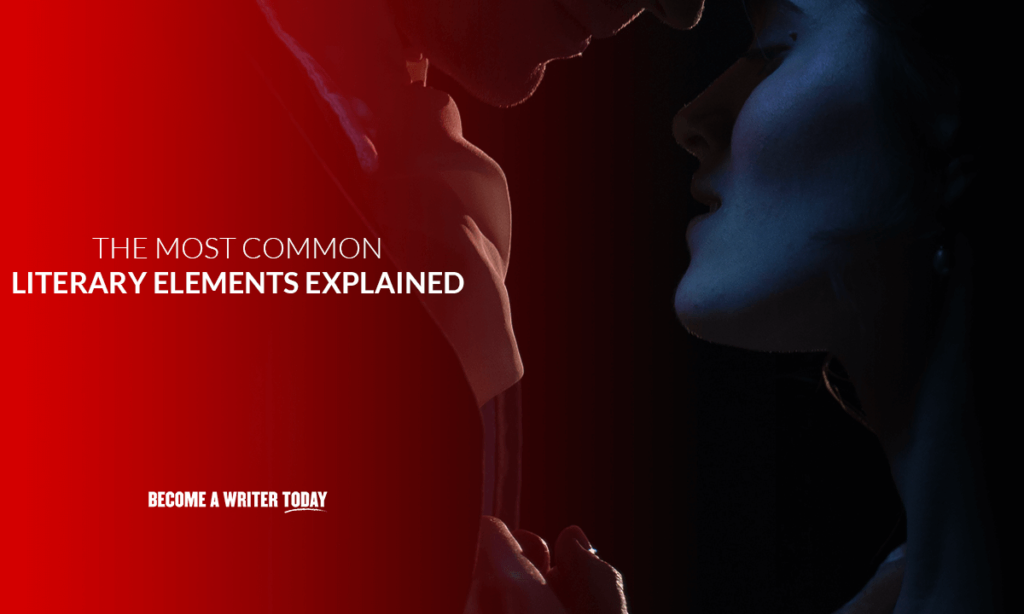While literary devices include a number of methods used to tell a story, literary elements are the pieces that make up the structure of the story itself.
When you’re studying a piece of literature, understanding what makes up a story can help you discuss and analyze it more effectively. By learning the literary terms for the elements you’d like to discuss, you can communicate more clearly, while garnering a better understanding yourself.
These are elements that are intrinsic parts of nearly every story. Once you learn to recognize them, you’ll be better able to analyze and understand any literature you read.
Contents
1. Language

Speaking broadly, this refers to the language a book is written in. Some books will use slang, dialect or other languages as part of the characterization of players in the novel. Their diction tells you about where they are from, their educational background and how the character wants to be perceived by others.
Example:
“Sometimes you gwyne to git hurt, en sometimes you gwyne to git sick; but every time you’s gwyne to git well agin.” – Jim from The Adventures of Huckleberry Finn.
Mark Twain spent hours listening to the accents and dialects of enslaved people to properly capture their speech. His word choices help us form a stronger picture of his characters.
Figurative language is also part of the literary element of language. Simile, metaphor and even devices like onomatopoeia all affect the mood of the writing and how the reader perceives it.
2. Mood
Speaking of mood, this is another important literary element. The mood of a piece of literature refers to the general feelings and emotions that the writer seeks to invoke. A story’s mood can be humorous, dramatic, frightening or sad.
Example:
SO STRANGE an accident has happened to us that I cannot forbear recording it, although it is very probable that you will see me before these papers can come into your possession.
– Mary Shelley’s Frankenstein
These words that begin the second chapter of Shelley’s book bring tension to the mood. They are foreshadowing that allows the reader to begin to anticipate the frightening things to come.
3. Plot

The plot of a work is the sequence of events that occur in a story. Most stories follow a plot structure that includes a beginning, conflict, rising action and eventually a climax, falling action and resolution.
As an example, the plot of Toni Morrison’s Beloved can be summarized like this:
A couple of has escaped from slavery and become prosperous is found by their former master. Desperate to avoid her family returning to enslavement, the mother kills her youngest daughter. Years later, she is visited by a woman who she is sure is the avenging ghost of her dead child.
4. Setting
The setting is simply the place and time period where a story occurs. Vividly drawn settings bring a literary work to life and help the reader become more engaged with the story. A short story may have only one setting. Longer works will typically have several.
As an example, Madeleine L’Engle’s A Wrinkle in Time begins in the prosaic setting of the family farmhouse in New England, then moves through fantastical settings on near and faraway planets.
5. Point of View
This is the narrator’s perspective on the story. A story can be first person, where the person telling the story is also a character in it, telling from their perspective.
It can, less commonly, be second person, such as is used in the Tom Robbins novel Half-Asleep in Frog Pajamas. It can be third person limited, where we see from an outside perspective without insight into all characters’ thoughts and motivations.
Or, it can be told in third person omniscient, where we learn what’s happening with all the characters at all times. Some works of literature may use multiple points of view.
6. Theme
The theme is the central message that the author wishes to convey. When looking for a story’s theme, try to figure out what the author is trying to teach or show through their writing. Many works have multiple themes.
The overarching theme of Erich Maria Remarque’s All Quiet on the Western Front is the brutality of war. The novel also explores the dangers of blind patriotism, the bonds that trauma will build between people, and the difficulty soldiers have going back to civilian life.
7. Characters
All literary works have at least one character. This character can be a person, an animal, or even an object or an abstract idea that has been personified. In Neil Gaiman and Terry Pratchett’s book Good Omens, War, Famine, Pollution, and Death all appear as living characters.
The main character is also known as the protagonist. This character is the central character in the story. A story will often also have an antagonist, who is in opposition to the main character.
Supporting characters will also often appear to interact with the main character and move along the plot. Characters are often archetypes, such as the hero, innocent, explorer, or outlaw.
The Final Word on Literary Elements
Literary elements can be thought of as the materials that construct a story. By understanding what they are, you can get a better understanding of the author’s intent and gain a deeper understanding of the work.
FAQ About Literary Elements
Why do you need to learn about literary elements?
Learning about literary elements helps us understand stories more thoroughly. It can also help people interested in creative writing construct their works.
Which literary elements are found in a poem?
There is no one set answer. A short poem may use devices like hyperbole or alliteration to evoke a mood or setting. A long epic poem may use as many elements as a modern novel.
Which literary elements are present in folk tales?
Folk tales and fairy tales often include archetypical characters, fanciful settings and colorful figures of speech.